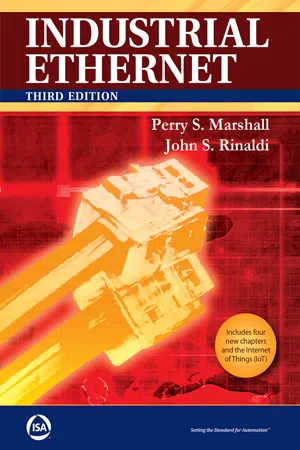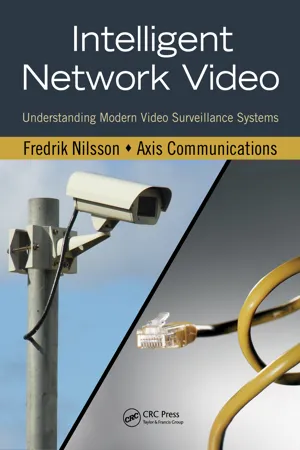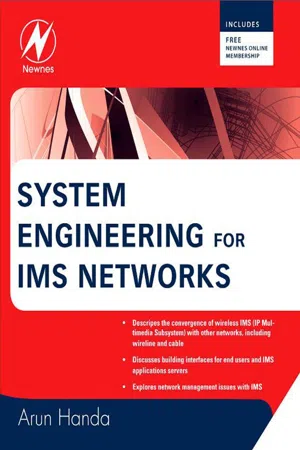IP Addressing
IP addressing is a method used to assign unique numerical labels to devices connected to a network, enabling them to communicate with each other. It allows for the identification and location of devices on a network, facilitating the transmission of data between them. IP addresses are essential for the functioning of the internet and other networks.
7 Key excerpts on "IP Addressing"
- James M Sinopoli(Author)
- 2009(Publication Date)
- Butterworth-Heinemann(Publisher)
...Their configurations can vary from a desktop PC to a mainframe computer. Most servers are built for a production environment with fast CPUs, multiple processors, hardware redundancy in disks and power supplies, large storage capacity and specialized operating systems and software applications. A server may be installed in an equipment rack or for high density may be a “blade” in a server chassis mounted in an equipment rack. IP Addressing Each physical connection of a device to an IP network has an IP address. The IP address is a numerical identification and a logical address of the device connected to the network. It is used to specify the routing source and destination of the transmission over the network. Originally an IP address was defined as a 32-bit (or binary numbers, 1s and 0s) number, a scheme referred to as Internet Protocol Version 4 (IPv4). Because of the growth of the Internet and the limits of IPv4, a new scheme was created to handle many more IP addresses. This is called Internet Protocol Version 6 (IPv6) and uses 128 bits for the IP address. There is also a set of IP addresses set aside for use in private or closed networks. Anyone can use these addresses in their private networks, probably supplemented with a translator to go from the private network to a public network such as the Internet. An example of an IP address is “162.146.93.14.” Behind the scenes that example IP address would be represented to a network in a 32-bit binary format: “10100010.10010010.01011101.00001110.” There are five “primary” classes of IP addresses. The first three, Classes A, B, and C can progressively handle more networks. Classes D and E are for multicasting and research. All Class A addresses and almost all Class B addresses have been allocated...
- eBook - ePub
Cybercrime and Information Technology
Theory and Practice: The Computer Network Infostructure and Computer Security, Cybersecurity Laws, Internet of Things (IoT), and Mobile Devices
- Alex Alexandrou(Author)
- 2021(Publication Date)
- CRC Press(Publisher)
...The IP address has two primary functions: it identifies the host’s or network interface identification and location addressing. When a computing device sends data to another device, the data headers contain information about the sending device’s IP address along with the destination device’s IP address. The IP address is like a physical home address for the computer that determines where the mail should be delivered. In 1982, when TCP/IP became the official protocol for ARPANET, IP addresses first emerged. As mentioned earlier, the first version of modern TCP was written in 1973 by Cerf and Kahn. The first and second Internet Protocols, IPv1and IPv2, were never defined; IPv3 and IPv5 were experimental. Internet Protocol 4, IPv4, was the first version that was used publicly and carried a theoretical limit of 4.3 billion (2 32) addresses. So far, IPv4 is the most popular version ever deployed. But, as the Internet grew exponentially, IPv4 ran out of IP addresses, especially after the emergence of mobile and IoT devices. As a result, in 1998, the Internet Engineering Task Force (IETF) created IPv6 to solve this problem. 24 In the 1980s, when IPv4 was first implemented, no one could have foreseen that in 20 years we would have more than four billion devices connected to the Internet. 24 The Internet Engineering Task Force. IPv6 is an Internet Standard. Retrieved from https://ietf.org/blog/ipv6-internet-standard/ and https://www.ietf.org/rfc/rfc2460.txt The organization that is responsible for allocating and maintaining global IP addresses is the Internet Assigned Numbers Authority (IANA). 25 IANA has been a division of the Internet Corporation for Assigned Names and Numbers (ICANN) since 1998 and is responsible for maintaining the Central Internet Address pools and the DNS root zone...
- eBook - ePub
Local Networks and the Internet
From Protocols to Interconnection
- Laurent Toutain, Ana Minaburo(Authors)
- 2013(Publication Date)
- Wiley-ISTE(Publisher)
...This addressing, called addressing by class, was kept until 1994 (see section 7.2.3). In 1994, address attribution rules were modified to take better advantage of the remaining address space available. This new method, called classless or CIDR (Classless Internet Domain Routing), currently in effect is described in section 7.2.4. This method, in conjunction with private addressing, has delayed the saturation of IPv4 addressing 5, enabling programmers to develop and implement IPv6. If attribution rules have evolved over time, the way addresses are used inside equipment has stayed pretty much the same. Thus, in the Internet an address is composed of a network part (called a prefix) designating the level 2 network on which the machine is connected and a part that is unique on the network, which designates the machine. In IPv6 terminology, the level 2 network is called a link. The number of entries required to locate recipients is reduced, since it only keeps a trace of the networks and not of all the recipients. The addressing plans currently defined for IPv6 maintain this principle. Therefore, an IP address does not represent a machine, but an interface to this machine. Since most equipment only has one interface, there can be confusion. On the other hand, if equipment has several network interfaces (routers, file servers connected to several networks, etc.), it will have just one IP address for each network it is connected to. Since the equipment is located by the prefix, if it changes network, it must change address. 7.2.1. Notation In principle, an IPv4 Internet address is noted as a series of four bytes in decimal separated by dots “.” for example: 192.48.96.2. IPv6 addresses are represented in hexadecimal by 16-bit words separated by “:”. To abbreviate the notation, one and only one sequence of bits set to 0 can be noted by “::”...
- eBook - ePub
Video Over IP
IPTV, Internet Video, H.264, P2P, Web TV, and Streaming: A Complete Guide to Understanding the Technology
- Wes Simpson(Author)
- 2013(Publication Date)
- Routledge(Publisher)
...This format, called dotted decimal, consists of a series of four numbers separated by periods (or “dots”). For example, 129.35.76.177 is the IP address for www.elsevier.com. Most folks who have had to configure their own home network or laptop connection have probably seen information in this form. A dotted decimal number represents a 32-bit number,which is broken up into four 8-bit numbers. 1 1. IP version 4, which is what is employed in the Internet today, uses 32-bit addresses. IP version 6 has a different addressing scheme, with 128 bits for each IP address. We will limit our discussions in the rest of the book to IP version 4, also known as IPv4. Of course, being human, we have a hard time remembering and typing all of those digits correctly (even when writing a book). Plus Elsevier might decide to change to a different Internet service provider that uses a different block of IP addresses for their web servers. To make life easy, the Domain Name System (DNS) was invented. DNS provides a translation service for web browsers and other software applications that takes easy-to-remember domain names (such as “elsevier.com”) and translates them into IP addresses (such as 129.35.76.177). Some IP addresses have special functions. For example, addresses in the range 224.0.0.0 through 239.255.255.255 are reserved for multicasting, which is discussed in Chapter 9. Other addresses are reserved for special functions, such as NAT, which is described later in this chapter. IP Packets Basically, IP works as a delivery service for IP packets. A packet is a single message unit that can be sent over IP, with very specific format and content rules. Since there are many excellent references available that talk about the structure of an IP packet, we'll just summarize, in Table 5-1, the key header elements that an IP packet needs to have and illustrate them in Figure 5-2. 2 2...
- eBook - ePub
- John Marshall(Author)
- 2017(Publication Date)
- International Society of Automation(Publisher)
...An IP address, on the other hand, is more portable and designates a “virtual” entity. A single IP address can represent one computer or a whole network of computers. Its virtual nature makes it portable and reassignable. Simply, a MAC address is like your name or social security number while an IP address is like your mailing address. Ethernet nodes already have a MAC address; the MAC address could be compared with my vehicle identification number (VIN), which designates a unique piece of hardware. Now if all you had was my VIN number, it might still be difficult to find me. Someone else could be driving my car; I might have several cars myself. An IP address is like my mailing address, which is more helpful because it points you directly to me. The Address Resolution Protocol (ARP) is the functional equivalent of calling the Department of Motor Vehicles and matching my VIN number to my postal address. It obtains the MAC address when the IP address is known. Reverse Address Resolution Protocol (RARP) is the exact opposite: Given a MAC address, it tells you the IP address. These two protocols allow the IP software to build the table of IP addresses and MAC addresses that are necessary to routing your message to its destination. IPv4 addresses, the kind we now use, are 32 bits long, but writing the individual bits out is tedious. Instead, IP addresses are split into 4 separate bytes, each having 8 bits, represented by dotted decimals. For example: 204.101.19.6 = 11001100 01100101 00010011 00000110 IPv4 addresses are in short supply, and a new IP protocol, version 6, will eventually replace IPv4. IP addresses are distributed by the Internet Assigned Numbers Authority (IANA); in turn, assignment of IP addresses is administrated by three sub-organizations: in Asia, www.apnic.net ; in the Americas, www.arin.net ; and in Europe, www.ripe.net...
- eBook - ePub
Intelligent Network Video
Understanding Modern Video Surveillance Systems, Second Edition
- Fredrik Nilsson, Communications Axis(Authors)
- 2016(Publication Date)
- CRC Press(Publisher)
...To make them more readable, IP addresses are grouped into four blocks of 1 byte (8 bits) each. The individual blocks (referred to as octets) are separated by a dot, and each block represents a decimal value between 0 and 255 (e.g., 85.235.16.37). This is known as dot-decimal notation. Each IP address consists of a network ID and a host ID. The network ID represents the logical IP network in which the host resides. The host ID represents the host itself. All devices with the same network ID will reside on the same network segment, meaning that these hosts can communicate directly with each other without the use of a router to forward the traffic to the correct network. IP addresses can be classified in five groups, referred to as classes (Table 11.1). These classes are based on the number range of the first octet of the IP address. Each class defines how many network and host addresses it has available. IP addresses used in LANs and WANs come from classes A, B, and C, with class C being used in most applications. Classes D and E are for multicast and experimental uses. Note, however, that the class-based addressing model of IPv4 is not commonly used today. Instead, Classless Interdomain Routing (CIDR) is used, which permits a more efficient use of the limited supply of IPv4 addresses. Table 11.1 Classes of Internet Protocol addresses Class Value range of first byte Bytes for net ID Number of networks Bytes for host ID Number of hosts A 1-126 1 126 3 16,777,214 B 128-191 2 16,384 2 65,534 C 192-223 3 2,097,152 1 254 D 224-239 Multicast addresses N/A N/A N/A E 240-254 Reserved N/A N/A N/A 11.2.3 Subnets An IPv4 address is divided into two parts: the network ID and the host ID. The subnet mask determines the blocks of an IPv4 address that define the network and host identifiers...
- eBook - ePub
- Arun Handa(Author)
- 2009(Publication Date)
- Newnes(Publisher)
...Layering helps to define a common set of functions that can be used for communication with peer entities. Often while designing network architecture, the lower protocol layers may be well abstracted if they have a mature implementation. Normally this is the case with IP protocols as well. The transport protocol set is quite transparent to an upper layer such as the session or application. From an IMS perspective, we will not focus much on the transport layer; however, we do have to understand the principles of addressing and routing as they apply to the network layer or to the session/application layer. Figure 3.1 The IP suite in IMS. 3.2 Addressing The current implementation of IP networks has been based on the IETF RFC 791 definition of the IPv4 protocol. Each entity in this network is identified by a unique 32-bit address. This is expressed as a four-octet (byte) scheme such as 192.168.1.100, which is illustrated in Figure 3.2. Figure 3.2 IP Addressing. IP addresses are further characterized into five classes of networks: Class A, B, C, D, and E. Mostly Class A, B, and C networks are used. Class D and E are reserved for multicast and experimental groups, respectively. Figure 3.3 describes the allocation of IP addresses in the various classes of networks. Figure 3.3 Classes of IP addresses. Given this scheme, with a 32-bit address format, 2 32 looks to be an impressive number to be able to handle 4 billion network devices. However, reflecting from Figure 3.3, administering a large network with 2 24 devices, approximately 16 million does not seem like a very large number. Large MNOs will need to administer multiple such networks, especially when devices go beyond cell phones. This will not be easy. Later, we will see how IPv6 is suitable to mitigate this problem. How are addresses allocated to endpoints? There are two methods: statically or dynamically. Static configuration of an address is to provision the address with an agreement with the network...






